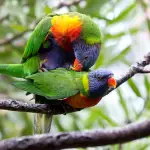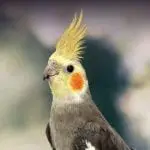The molting process in parrots is just a natural shedding process. It happens for about at least two months to lose their old feathers so that they can produce a new one. Commonly, the parrots go through beyond this process once or even twice a year.
During this moment, parrots produce pin-like growths or also known as a ‘pin feather.’ It comes from their skin follicles. In parrots, this is usually uncomfortable or itchy. So it is essential that you make certain your pet parrot feels comfortable as much as possible during these molting processes.
Making Your Pet Parrot More Comfortable During Molting Process

Spray some water droplets to your pet parrot twice every day to make your pet feel comfortable. Misting your parrot may give them an extra mugginess to their cage that lessens their itchy and uncomfortable feeling. Just use some spray bottles to haze your parrot with room-temperature water.
Other misting advantages include:
- Routinely misting your parrot makes the hard sheath soften that makes around the parrot’s pin feathers. By the use of misting regularly, this will make the parrot’s feather easier to remove once that the new feathers are already grown in.
- In parrots, they think that misting is just like rainfall to them. You may do this process for at least two or three times every week, even if your pet is not in the molting process.
- Another way of making your parrot feels comfortable while the molting process is just to let them rest more than usual. Your pet may be in an irritable condition, or it may show some shivering behavior while it is on a molting process. It is because, as mentioned earlier, they feel itchy and uncomfortable. Apparently, avoid disturbing your pet while it is sleeping or resting. Put your pet in a dark place where it might be got disturbed for about 12 to 13 hours each day within the molting process. You need to have patience with your pet and just let them rest as long as they need it. Sufficient rest is essential to help for the development of the parrot’s new feathers.
How to Prevent Your Parrot from Petting While Pin Feathers Grow
The pin feathers are usually filled with blood, and they are very subtle if they are beginning to grow in. Therefore, petting your pet eagerly might harm your pet, and it may hurt them. Avoid petting your pet during this process. You can continue petting your parrot again without a tendency of hurting them once their feathers have grown in the hard sheath that’s around in the base of their feather flakes. It usually takes place within the end of the molting process.
Keep Your Pet Parrot in a Room-temperature Space

During your pet parrot’s feathers molting process, it may be more liable for them to have a chilly waft. So make sure that room, where your parrots stay, has a room temperature or generally has about 70 °F or 21 °C. Stay away from your pet form any windows or open doors if it is cold outside.
Even the parrots are known to be as a type of tropical bird, a room that is too hot for them during the molting process may cause discomfort to the parrot. Once the feather of your parrots is growing, you may roll your finger along with your pet’s head and neck. The parrots can commonly take away its old feathers, but there are a few feathers that may remain on the spots that your pet might not reach, like in the part of the parrot’s head or in their neck.
Here are some tips for pet owners during the molting process:
1. Wait for New Feathers to Grow
As a pet owner, you need to wait for the new feathers to grow. Also, when the hard sheath area that is around the base of your parrot’s feather that begins to flake, slightly roll your finger along with the parrot’s head and its neck to take away the flaky sheath in your parrot.
2. Know When It’s Ready or Not
The feather is not ready to come out of the sheath of your pet parrot if it is still hard and glassy. However, if your pet parrot has a partner, its partner will generally take away its old feathers located on the parrot’s head and neck.
But if it does not have any partner, as a pet owner, you’re the one who is supposed to do it. It is crucial to wait until the feather of your pet is fully developed, or you’ll just end up hurting your pet as you do this.
Food to Feed your Parrot

You may feed your pet at least a slice of cucumber to have an extra protein every day. During that process that your pet grows its new feathers; they may need to have more nutrients. Other than any kind of food included in your parrot’s diet, feeding your pet just one slice of fresh cucumber provides an added source of nutrients for your pet.
Expand the amount of protein that your pet eats by providing it an egg food or as simple as a hard-boiled egg yolk every day. By doing so, it will assist your pet to grow new strong and healthy feathers.
Here’s how to feed your pet parrot:
- The first thing you need to do is wash the cucumbers thoroughly before you feed it to your pet to take away any harmful pesticides in cucumber.
- Avoid feeding your pet more than one slice of a medium-sized cucumber per day, or else you may overfeed your parrot.
- Routinely remove any fresh food from your pet’s cage every day so that the food does not get fusty.
When to Bring Your Pet Parrot to a Vet
If your pet is not eating the proper diet that it needs or it is light cycle is off, this may cause your pet to have a molting process for more than twice a year. So always make sure that you provide your parrot the right amount of food that contains nutrients while it is in the process of molting.
Furthermore, most parrots should receive at least 10 up to 12 hours of sunlight and 10 up to 12 hours of darkness every day. If you know that you are taking care of your pet in the right way and it is still molting for more than twice a year, then this could be a clear sign that your parrot is under stress condition or the reason could be more serious that prompts medical attention.
Other causes of molting in parrots are:
- Typically, most parrots molt at different times. It depends on the type of species, but it commonly happens after the mating season.
- When your pet is not acquiring enough sunlight, it might change the molting scheme and how it is usually that you’re pet molts.
- Bring your pet to the veterinarian if the pin of its feather begins to bleed. Usually, pin feathers are full of blood, and it is not commonly lumped if it is damaged. This might be the reason why that your parrot may bleed out if one of its pinfeathers is broken. Try to observe your pet if this might happen; the pin feathers must be required to remove from your parrot’s follicle by an avian veterinarian, if you don’t, there might be a tendency that your bird could die.
Conclusion
Now you fully understand the molting process, including the indicative signs. Also, you’re more confident to take good care of your parrot during this process of changing feathers. You know when to avoid stress and ensure that your parrot stays healthy and happy.



